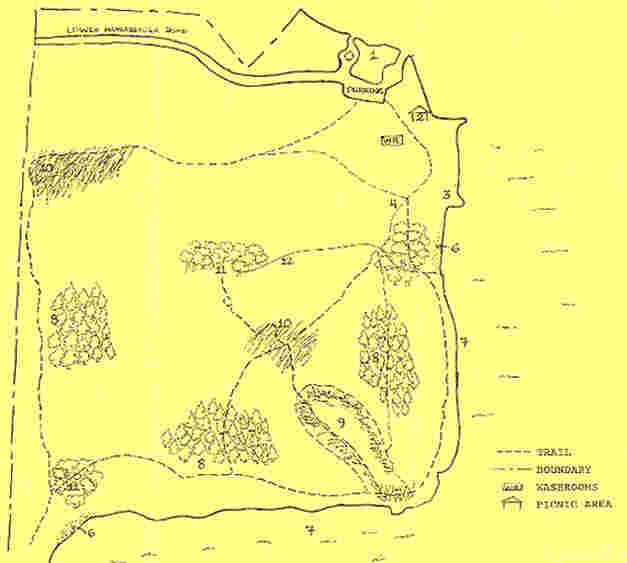 A Walking Tour of the
A Walking Tour of the Massassauga Point Conservation Area
 A Walking Tour of the
A Walking Tour of the
Massassauga Point Conservation Area
Walking
Tour Map

An Historical, Flora and Fauna, Walking
Tour
(Match the numbers with the map)
| 1. This is the
first of many historical sites of Massassauga Point. The dance pavilion
built here around the time of World War I was just one of the many social
activities the Point was famous for. Yachting, cricket and picnicking were
also very popular. 2. At this picnic area, looking over to Point Anne, you will see the view that made the Point such a popular place. Steamers regularly transported visitors to the resort, where they disembarked at the Hotel dock. As you walk towards the site of the old Hotel, look for an old path and the hickory trees that once earned the resort the name of "Hickory Nut Plains". 3. Here is the original site of the Hotel built sometime before 1879. In 1878, half of the land was owned by the Wallbridge family and they began the era; in 1886 they sold this part to the Anderson family. A dispute between the families resulted in the closing of the only access road and led to the end of the Point as a resort. 4. Look through the trees along the ground for various foundations likely of the outbuildings and cottages that surrounded the Hotel. The site of the old well is also in this grove. 5. This is one
of the low areas on the Point and a small, seasonal stream runs through
and empties into the Bay. 6 & 7. The beach and shore areas surround the Point and are generally cool and dry. The vegetation here needs abundant water and Hedge Bindweed, Canada Anemone, Gill-over-the-Ground, Eastern Cottonwood and Black Willow can be seen all around the Point. Though it is fully exposed to wind and sun, it is used as a source of water for the animals of the Point and Northern Water snakes sun themselves here. Great Blue Herons and Mallards are also seen and Swallows often dodge the waves on windy days. 8. A predominant
area of the Point is covered by Cedar Scrub, consisting mainly of Red
Cedar. Its ability to survive in shallow soil with little moisture
makes it one of the stronger strains of tree, and often crowds out the
seedlings of the mature Bur Oak, Red Oak, Red Ash and European Buckthorn.
There are also a number of flowering weeds present in the spring such
as Dandelions, Mint, Hawkweed, Bedstraws and Buttercups. Look for
Trout Lilies and Herb Robert
|
9. As you come upon
the deserted Quarry you will first see the marsh and the site of the old
dock, where we now have a comfortable bench on which to rest while you enjout
the lake vista. Around the marsh, Eastern Cottonwood, Purple Loosestrife,
Square- stemmed Monkey-Flower, Summer Grape, Sedge, Fern Ally and grasses
can be found. As you walk through the Quarry you will see that only
Staghorn Sumac, Cinquefoil Species, Summer Grape and the durable Herb Robert
manage to survive on the barren quarry floor. See if you can find
evidence of the Coyotes that have been known to den here. Look for tracks
and other signs of this animal. 10. The Meadows provide
food for the deer and cottontails in a variety of plants that can withstand
long, dry periods. Viper's Bugloss, Hawkweeds, Yarrow, Skullcaps, Cinquefoils
and Goat's Beard are types of vegetation you will see here. Sedges
can be found in marshy areas in the early spring. The meadows also
support vegetation characteristic of alvars - areas of shallow soil over
limestone - though they are not technically recognized as such.
Long-plumed Purple Avens, Tall Cinquefoil, Sleepy Catchfly, Mouse Ear
Chickweed and Smaller Skullcap are all indicative of alvars. We have also
identified death (white) camus, snow berry, narrow leaf jersey tea and
wild onions. This is a fragile, special area and should be appreciated.
11. The Ash and Hickory
Forest is well worth your while to go a little out of the way to see.
This low lying, wet area supports tree species such as Black Ash, Red
Ash Shagbark Hickory, Bur Oak, Ironwood and Basswood. Its seclusion
from the rest of the Point helps this area to maintain its diverse plant
life and some of the more unusual vegetation of the area. Look
for Spotted Joe-pye-weed, Elecampane, White Lettuce, TrilHun:i, Wild Bergamot,
Bloodroot and Pipsissewa. 12. The Seasonal Stream
found in the Ash and Shag Bark Hickory Forest travels through the Bur
Oak Grove as well, carrying the winter runoff into the Bay keeping this
low lying area wet throughout the growing season. PLEASE REMEMBER: Take nothing but pictures, leave nothing but footprints. DO NOT distrub the flowers!
|